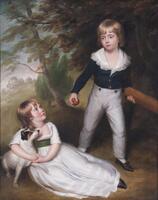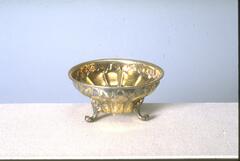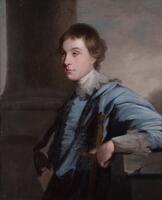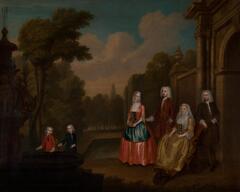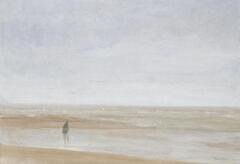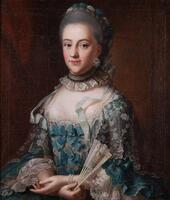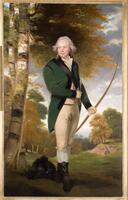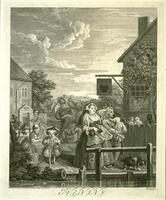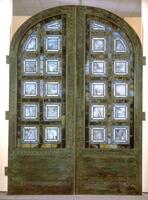The stories behind the paintings - war, slavery, scandal and tragedy.
15 Items in this Learning Collection
Resource with 3 media
Collection Object
Collection Object
Resource with 1 media
Resource with 2 media
Resource with 1 media
Collection Object
Resource with 1 media
Resource with 4 media
Resource with 1 media
Collection Object
Resource with 5 media
Collection Object
Resource with 3 media
Collection Object
Copyright
All Rights Reserved
(<p>Collection created by Sophie Grillet</p>)
The Four Times of Day: Evening
Accession Number
1971/2.58
Title
The Four Times of Day: Evening
Artist(s)
William Hogarth
Object Creation Date
1738
Medium & Support
etching and engraving on laid paper
Dimensions
18 1/4 in. x 15 7/8 in. ( 46.4 cm x 40.3 cm )
Credit Line
Museum Purchase
Label copy
*Gallery Rotation Winter 2011 (January 2011)
[Hogarth intro label]
Hogarth created several series of images, such as The Rake’s Progress and Marriage à la Mode, satirizing the mores and values of eighteenth-century England. In The Four Times of Day—a series of prints made after his paintings and intended for a wider audience—Hogarth employed humor both to comment on contemporary society and to breathe new life into the genre of images that marks the progression of time by depicting the seasons, the stages of life, or the times of day.
Turning a long tradition on its head, Hogarth’s portrayals of the times of day (morning, noon, evening, and night) are situated in specific locations in contemporary London rather than an in idealized classical past. Each of the sites he chose was considered disreputable in its day and the congested settings act as foils and contexts for the figures. In this way the pastoral, eternal, and ideal images of Greek and Roman gods and goddesses so often encountered in traditional paintings in this genre become urban, specific, and comic. In addition to creating a specifically English kind of imagery, Hogarth disrupts the tradition linking the times of day with particular seasons, i.e. morning with spring, midday with summer, evening with fall, and night with winter. Instead his cycle begins with winter, which he links to morning, and ends with autumn, which he links to night.
Gallery Rotation Winter 2011
William Hogarth
England, 1697–1764
The Four Times of Day: Evening
1738
Etching and engraving
Museum purchase, 1971/2.58
Evening shows a young dyer’s family escaping the summer heat in the city to enjoy the lush middle-class resort of Sadler’s Wells on the outskirts of London, a location famous for its waters and theaters; once exclusive, by the eighteenth century it was considered “a nursery of debauchery.” The couple stroll past a tavern and a cow being milked, suggesting the evening hour. The placement of the cow’s horns behind the husband’s head indicates that his wife has been unfaithful to him—a notion that was traditionally expressed in European art and literature by the wearing of horns. The children behind the couple replay the scene as a girl demands a smaller boy’s cookie.
Subject matter
Hogarth created several print series that satirize mores and values of 18th century England. In his suite, "The Four Times of Day," executed after a series of paintings, he employed humor, not just to comment on London society but to breathe new life into images marking the times of day. Hogarth translated portrayals of the times of the day from their pastoral origins to that of contemporary London. The pastoral, eternal and ideal here become urban, specific and comic. Each of the London sites shown in this series was considered disreputable in its day and the congested setting acts as a foil and context for the figures.
Set in a lush summer setting, "Evening," shows a young dyer’s family escaping the heat of the city to enjoy the middle class resort of Sadler’s Wells. The dyer accompanies his formidable wife as they stroll past a tavern and a cow being milked. The placement of the cow’s horns behind the husband’s head indicates that he is a cuckold; the pair of children on the left of the composition underscores the unfortunate situation of the male, in each instance dominated by a larger female.
Physical Description
This print is vertically oriented with gray markings. A cream border surrounds it and it has “EVENING” written below it. The lower half of the print has a pastoral scene with several adults and children by a stream at the bottom of the print. Behind them, someone milks a cow. The upper half shows the tops of buildings and rolling hills. A sunset is taking place with dramatic clouds.
Primary Object Classification
Print
Primary Object Type
intaglio print
Additional Object Classification(s)
Print
Collection Area
Western
Rights
If you are interested in using an image for a publication, please visit http://umma.umich.edu/request-image for more information and to fill out the online Image Rights and Reproductions Request Form.
Keywords
clouds
cows (mammals)
offspring
people (agents)
rivers
taverns
1971/2.58
Title
The Four Times of Day: Evening
Artist(s)
William Hogarth
Object Creation Date
1738
Medium & Support
etching and engraving on laid paper
Dimensions
18 1/4 in. x 15 7/8 in. ( 46.4 cm x 40.3 cm )
Credit Line
Museum Purchase
Label copy
*Gallery Rotation Winter 2011 (January 2011)
[Hogarth intro label]
Hogarth created several series of images, such as The Rake’s Progress and Marriage à la Mode, satirizing the mores and values of eighteenth-century England. In The Four Times of Day—a series of prints made after his paintings and intended for a wider audience—Hogarth employed humor both to comment on contemporary society and to breathe new life into the genre of images that marks the progression of time by depicting the seasons, the stages of life, or the times of day.
Turning a long tradition on its head, Hogarth’s portrayals of the times of day (morning, noon, evening, and night) are situated in specific locations in contemporary London rather than an in idealized classical past. Each of the sites he chose was considered disreputable in its day and the congested settings act as foils and contexts for the figures. In this way the pastoral, eternal, and ideal images of Greek and Roman gods and goddesses so often encountered in traditional paintings in this genre become urban, specific, and comic. In addition to creating a specifically English kind of imagery, Hogarth disrupts the tradition linking the times of day with particular seasons, i.e. morning with spring, midday with summer, evening with fall, and night with winter. Instead his cycle begins with winter, which he links to morning, and ends with autumn, which he links to night.
Gallery Rotation Winter 2011
William Hogarth
England, 1697–1764
The Four Times of Day: Evening
1738
Etching and engraving
Museum purchase, 1971/2.58
Evening shows a young dyer’s family escaping the summer heat in the city to enjoy the lush middle-class resort of Sadler’s Wells on the outskirts of London, a location famous for its waters and theaters; once exclusive, by the eighteenth century it was considered “a nursery of debauchery.” The couple stroll past a tavern and a cow being milked, suggesting the evening hour. The placement of the cow’s horns behind the husband’s head indicates that his wife has been unfaithful to him—a notion that was traditionally expressed in European art and literature by the wearing of horns. The children behind the couple replay the scene as a girl demands a smaller boy’s cookie.
Subject matter
Hogarth created several print series that satirize mores and values of 18th century England. In his suite, "The Four Times of Day," executed after a series of paintings, he employed humor, not just to comment on London society but to breathe new life into images marking the times of day. Hogarth translated portrayals of the times of the day from their pastoral origins to that of contemporary London. The pastoral, eternal and ideal here become urban, specific and comic. Each of the London sites shown in this series was considered disreputable in its day and the congested setting acts as a foil and context for the figures.
Set in a lush summer setting, "Evening," shows a young dyer’s family escaping the heat of the city to enjoy the middle class resort of Sadler’s Wells. The dyer accompanies his formidable wife as they stroll past a tavern and a cow being milked. The placement of the cow’s horns behind the husband’s head indicates that he is a cuckold; the pair of children on the left of the composition underscores the unfortunate situation of the male, in each instance dominated by a larger female.
Physical Description
This print is vertically oriented with gray markings. A cream border surrounds it and it has “EVENING” written below it. The lower half of the print has a pastoral scene with several adults and children by a stream at the bottom of the print. Behind them, someone milks a cow. The upper half shows the tops of buildings and rolling hills. A sunset is taking place with dramatic clouds.
Primary Object Classification
Primary Object Type
intaglio print
Additional Object Classification(s)
Collection Area
Western
Rights
If you are interested in using an image for a publication, please visit http://umma.umich.edu/request-image for more information and to fill out the online Image Rights and Reproductions Request Form.
Keywords
clouds
cows (mammals)
offspring
people (agents)
rivers
taverns
